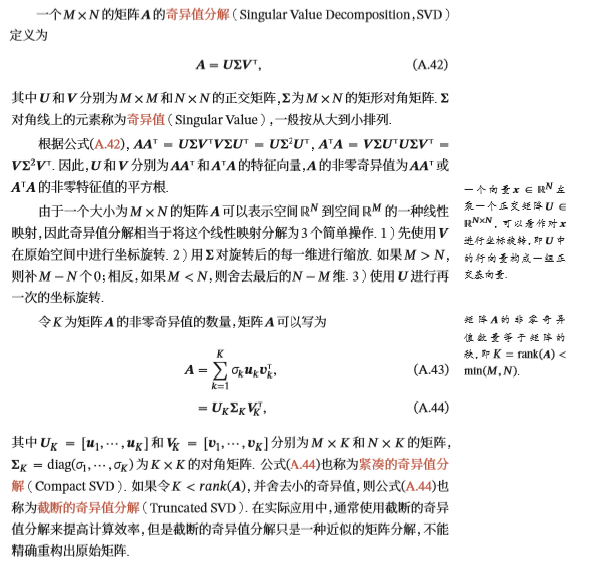奇异值分解(SVD和TruncatedSVD)
1.两者概念理解

2.SVD的使用
np.linalg.svd(a, full_matrices=True, compute_uv=True)
参数:
-
a : 是一个形如(M,N)矩阵
-
full_matrices:的取值是为0或者1,默认值为1,这时u的大小为(M,M),v的大小为(N,N) 。否则u的大小为(M,K),v的大小为(K,N) ,K=min(M,N)。
-
compute_uv:取值是为0或者1,默认值为1,表示计算u,s,v。为0的时候只计算s。
返回值:
- 总共有三个返回值u,s,v,其中s是对矩阵a的奇异值分解。s除了对角元素不为0,其他元素都为0,并且对角元素从大到小排列。s中有n个奇异值,一般排在后面的比较接近0,所以仅保留比较大的r个奇异值。
Corpus(window_size=1):
I like learning.
I like NLP.
I enjoy flying.
1 import numpy as np 2 3 import matplotlib.pyplot as plt 4 plt.style.use('ggplot') 5 6 7 words =['I', 'like', 'enjoy', 8 'deep', 'learning', 'NLP', 'flying','.'] 9 10 X = np.array([[0,2,1,0,0,0,0,0], #X是共现矩阵 11 [2,0,0,1,0,1,0,0], 12 [1,0,0,0,0,0,1,0], 13 [0,1,0,0,1,0,0,0], 14 [0,0,0,1,0,0,0,1], 15 [0,1,0,0,0,0,0,1], 16 [0,0,1,0,0,0,0,1], 17 [0,0,0,0,1,1,1,0]]) 18 U, s, Vh = np.linalg.svd(X, full_matrices=False) 19 print(U.shape) #(8, 8) 20 print(s.shape) #(8,) 21 print(Vh.shape) #(8, 8) 22 print(np.allclose(X, np.dot(U * s, Vh))) #True,allclose比较两个array是不是每一元素都相等,默认在1e-05的误差范围内 23 24 plt.xlim([-0.8, 0.2]) 25 plt.ylim([-0.8, 0.8]) 26 for i in range(len(words)): 27 plt.text(U[i,0], U[i,1], words[i])

3.TruncatedSVD的使用
TruncatedSVD 的创建必须指定所需的特征数或所要选择的成分数,比如 2。一旦创建完成,你就可以通过调用 fit() 函数来拟合该变换,然后再通过调用 transform() 函数将其应用于原始矩阵。
1 from sklearn.decomposition import TruncatedSVD 2 svd = TruncatedSVD(n_components=2) 3 X_reduced = svd.fit_transform(X) #X是上面的共现矩阵,两步合一步 4 print(X_reduced)
[[ 1.44515015 -1.53425886]
[ 1.63902195 1.68761941]
[ 0.70661477 0.73388691]
[ 0.78757738 -0.66397017]
[ 0.53253583 0.09065737]
[ 0.8413365 -0.78737543]
[ 0.50317243 -0.4312723 ]
[ 0.68076383 0.42116725]]
手动计算得到的值与上面调用函数的结果一致,但某些值的符号不一样。由于所涉及的计算的性质以及所用的基础库和方法的差异,可以预见在符号方面会存在一些不稳定性:
1 Vh = Vh[:2, :] 2 print(X.dot(Vh.T))
[[-1.44515015 -1.53425886]
[-1.63902195 1.68761941]
[-0.70661477 0.73388691]
[-0.78757738 -0.66397017]
[-0.53253583 0.09065737]
[-0.8413365 -0.78737543]
[-0.50317243 -0.4312723 ]
[-0.68076383 0.42116725]]





